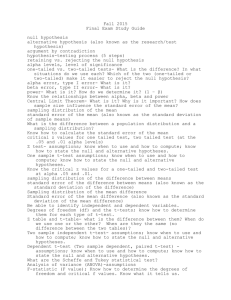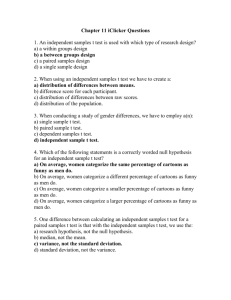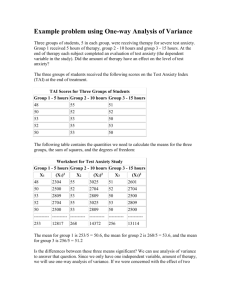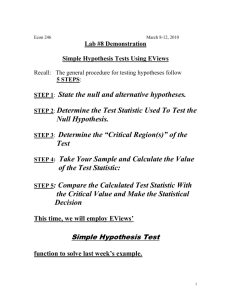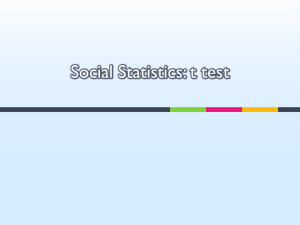Statistics for Dummies
advertisement
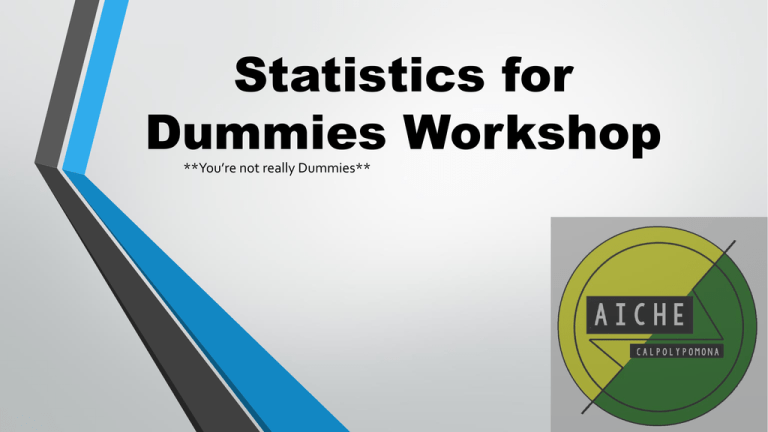
Statistics for Dummies Workshop **You’re not really Dummies** Before Starting • Disclaimer: We can’t teach a whole quarter of statistics, but we can teach you how to study. Studying for statistics requires reading the book! • If you are not reading on your own and just taking notes in class, you are likely not to succeed • Upper Level classes will automatically assume you have learned to study the material • DO NOT Chegg or Google the solutions What’s going to be covered • Diagrams • Data Summary and Presentation • Binomial distribution • Engineering/Statistics Toolbox • Z-test • Type 2 Error • T-test • C2 Test Dot Diagram Box Plot Q1 Q2 Q3 x = 1550 1.5 IQR IQR IQR = Inter Quartile Range 1.5 IQR 1030 1040 1050 1060 1070 1080 Histogram Frequency Cumulative Frequency 25 70 60 20 50 15 40 30 10 20 5 10 0 20 30 40 50 60 70 80 0 20 30 40 50 60 70 80 Data Summary Stem and Leaf Diagram Correlation Coefficient n R= S i=1 (xi – x)(yi – y) n (S )( S n (xi – x)2 i=1 i=1 ) (yi – y)2 Stem 1 2 3 4 5 7 8 Leaf 3 245 36814 4624563 5252 4 Freq. 1 3 5 7 4 0 1 Quartile/Percentile Calculation Quartile 1st (n + 1) 4 2nd 2(n + 1) 4 3rd 3(n + 1) 4 Percentile 5th .05(n + 1) 95th .95(n + 1) Value will give ordered observation Interpolate as needed Binomial Distribution P(X = x) = ( ) p (1-p) n! ( ) = x!(n – x)! n x n x x n-x We use Binomial Distribution when: 1. Trials are independent 2. Each trial results in one of two possible outcomes, success or failure ooooh! 3. The probability, p, remains constant Engineering/Statistics Toolbox • Known as the procedure for hypothesis testing Steps for Generic Hypothesis Testing • • • • • • 1. Identify Parameter Of Interest: • For instance; determine the saltiness of a potato chips 2. State the Null Hypothesis (H0): • Standard that you are testing against, like the given average students test scores 3. Alternative Hypothesis (H1): • Specify an appropriate alternative hypothesis 4. Test Statistic • Equation you are going to use for each test. Z = X-m/(s/n^.5) 6. Computations • Plug and chug 7. Conclusion • Decide whether the Null Hypothesis should be rejected and report and that in the problem context. Z-Test • When do you use it? • • Known mean and known variance Gives the probability density of when something is going to happen • Most of the time an alpha value will be given to you • If not, assume 0.05 Type II Error • • • • When you fail to reject the null hypothesis when it is wrong then you have committed a type II error b = f(Z0) Power = 1 - b For instance: Say you have a pop. of 50 beads with an average diameter of 10 mm (actual average diameter). However, your sample of 10 beads has an average of 15 mm. You want to confirm that a null hypothesis of 15 inches is correct. If you fail to reject the null you messed up. T-Test • Unknown variance and known mean • You need to determine the sample variance • You need to know degrees of freedom • That will be n-1, (n is the sample size) • Literally the same as the Z-test except with degrees of freedom and sample variance C2-Test • This is a test on the sample variance • Much the same as T-test • Must know the sample variance, as well as the actual variance • This tests variance, NOT standard deviation


